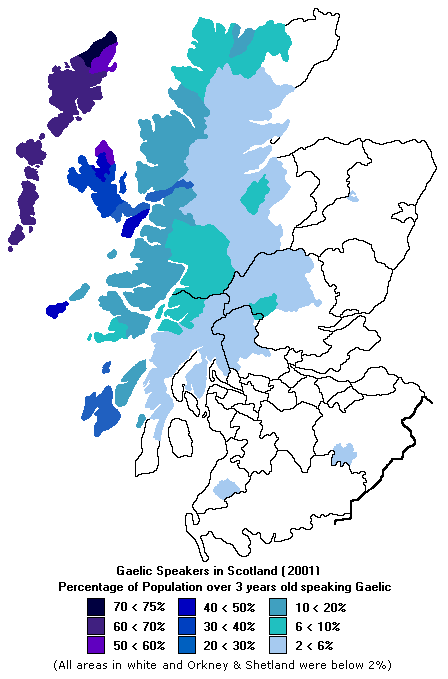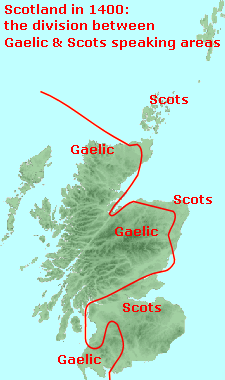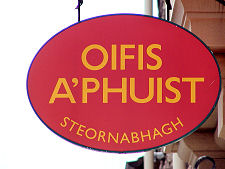 Gaelic Speakers in Scotland, 2001 Note About Image Copyright |
Scottish Gaelic, or Gàidhlig, belongs to the Goidelic branch of Celtic languages, which also includes the Irish and Manx Gaelic. It is only more distantly related to the Brythonic branch of the Celtic languages, which includes Welsh, Cornish, and Breton. Scottish, Manx and Irish Gaelic are all descended from Old Irish.
The relationship between Scottish and Irish Gaelic is no coincidence. Scottish Gaelic was the language of the Scots of the Kingdom of Dalriada, who probably migrated to what is now Argyll from Ireland. With the domination of the Picts by the Scots in the 800s, Scottish Gaelic replaced Pictish across a large part of Scotland, and it subsequently replaced the Cumbric spoken by the residents of the Kingdom of Strathclyde when they, too, became dominated by their Scottish Gaelic-speaking neighbours. Still later, Gaelic succeeded in displacing Old Norse in many of the previously Viking-dominated areas of western and northern Scotland.
The high water mark in the spread of the influence of Scottish Gaelic across the country was probably in about 1300. It never gained much of a foothold in South-East Scotland, where the main language was the Middle English variant known as Early Scots, which had started life as the Northumbrian Old English spoken by the Angles who once dominated this part of Scotland.
By about 1400 this language had pushed Gaelic from much of central Scotland, the eastern fringe of much of the country and the Northern Isles. The retreat of Scottish Gaelic seems to have paused for some time at the Highland Line, but by the 1700s it had been pushed back from here too. The story thereafter is picked up in the table below. In 1755, 22.9% of a total Scottish population of 1,265,380 could speak only Scottish Gaelic. By 1800 the total number of Gaelic-only speakers had risen slightly, but the proportion had dropped to 18.5% of a much larger population of 1,608,420. And by 1891 the picture had changed utterly, with not much more than 1% of a population of 4,025,647 being able to speak Scottish Gaelic only, while only about 5% were bilingual in Gaelic and English.
In 1971 Gaelic-only speakers had declined to 477. Subsequent censuses have not asked a question on Gaelic-only speakers. The 2011 Census recorded 57,375 people living in Scotland who could speak Gaelic, or 1.1% of the population. This was the lowest figure ever, though the decline had slowed markedly during the precending 10 years. The incidence of Gaelic speakers within Scotland is shown in the header map: with the proportion of people able to speak Gaelic increasing steadily as you progress west across the country and, especially to the islands: with the highest density, at just under 75%, in northern Lewis. It must be remembered however that in 2001 some 45% of all Gaelic speakers were resident outwith the Highlands and Islands altogether, chiefly across the Central Belt.
A word about terminology is helpful here, because any discussion of the development of Scottish Gaelic and Scots has a very large pitfall lying in wait for the unwary. When what we now call Early Scots was developing into what we now call Scots, speakers of that language, and of English, referred to Gaelic as "Scottis", or even as "Scots". There was a logic in this, as it had been the Scots who introduced the language to Scotland. However, when what the people called at the time "Lowland Scots" became increasingly dominant in the 1500s, English speakers began using the word "Scots" to describe "Lowland Scots". Gaelic, previously called "Scots", became known as "Erse", a word still seen in books written at the end of the 1700s. The word "Gaelic" only came into common use in the 1800s.
The reasons for the decline in Gaelic at the expense of Scots and Scottish English over the past 700 years are complex. But by far the most important has been the historical dominance of central Scotland, and Edinburgh in particular, over the political and economic development of Scotland. This area was never Gaelic-speaking to start with, and it was probably inevitable that the language it used would have a disproportionate influence across the rest of the country. Added to this was the growing influence, especially on the ruling classes (and everyone who aspired to be a member of the ruling classes) of English. This grew significantly after James VI had headed south to London on inheriting the English crown in 1603, and again following the Act of Union of the English and Scottish Parliaments in 1707. Suddenly even the use of Scots was not enough to be seen as having "arrived" in society: and language, especially the spoken language among the upper classes and written language more widely, became Anglicised into what is now known as Scottish English.
Add into this picture a long held view amongst many Lowlanders until as late as the 1800s that the main users of Scottish Gaelic, Highlanders, were, at best, second class citizens, and the decline was probably inevitable. And this was before the systematic suppression of the way of life of the Highlanders in the second half of the 1700s, which continued to have echoes in education policies in Gaelic-speaking areas until much more recently: English was the only language allowed to be used in schools in the Gaelic-speaking Western Isles until well into the 1900s.
It was belatedly recognised that the inexorable decline in Gaelic was endangering an important part of the culture and heritage of large areas of Scotland. Efforts have belatedly begun to reverse the decline. These include the Scottish Parliament's Gaelic Language (Scotland) Act 2005, which afforded the language a degree of official recognition, and the adoption of Gaelic as the primary language of Comhairle nan Eilean Siar, or the Western Isles Council. Meanwhile road signs across the Highlands are increasingly appearing in bilingual form, and the Ordnance Survey has adopted Gaelic names on its maps of the Western Isles. It has set up a group to determine the correct Gaelic form of other place names across Scotland. Whether spending large amounts of money on doubling the number of names on road signs (and so making them much less useful as road signs) is the most cost-effective way to promote Gaelic is debatable, and debated. What is more clear cut is that Scotland without Gaelic would be like Scotland without heather moorland: no-one would starve as a result, but as a nation we'd all be immeasurably poorer.
Gaelic speakers in Scotland (1755 - 2011) |
||||
| Year | Scottish population | Speakers of Gaelic only | Speakers of Gaelic & English | % Speakers of Gaelic & English |
| 1755 | 1,265,380 | 289,798 | Not recorded | 22.9 Gaelic only |
| 1800 | 1,608,420 | 297,823 | Not recorded | 18.5 Gaelic only |
| 1891 | 4,025,647 | 43,738 | 210,677 | 5.2 |
| 1901 | 4,472,103 | 28,106 | 202,700 | 4.5 |
| 1911 | 4,760,904 | 18,400 | 183,998 | 3.9 |
| 1921 | 4,573,471 | 9,829 | 148,950 | 3.3 |
| 1931 | 4,588,909 | 6,716 | 129,419 | 2.8 |
| 1951 | 5,096,415 | 2,178 | 93,269 | 1.8 |
| 1961 | 5,179,344 | 974 | 80,004 | 1.5 |
| 1971 | 5,228,965 | 477 | 88,415 | 1.7 |
| 1981 | 5,035,315 | Not asked | 82,620 | 1.6 |
| 1991 | 5,083,000 | Not asked | 65,978 | 1.4 |
| 2001 | 5,062,011 | Not asked | 58,650 | 1.2 |
| 2011 | 5,295,000 | Not asked | 57,375 | 1.1 |




